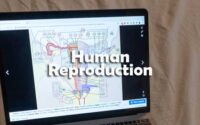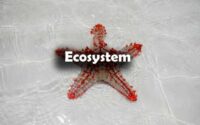Organisms and Populations
1. Presence of plants arranged into well defined vertical layers depending on their height can be seen in—
A. Tropical Savannah
B. Tropical Rain Forest
C. Grassland
D. Temperate Forest
2. Asymptote in a logistic growth curve is obtained when—
A. The value of ‘r‘ approaches zero
B. K = N
C. K > N
D. K < N
3. The principle of competitive exclusion was stated by—
A. C. Darwin
B. Verhulst and Pearl
C. Mac Arthur
D. G F Gause
4. If ‘+’ sign is assigned to beneficial interaction ‘-‘ sign to detrimental and ‘0’ sign to neutral interaction, then the population interaction represented by ‘+’ ‘—’ refers to—
A. mutualism
B. amensalism
C. parasitism
D. commensalism
5. Gause‘s principle of competitive exclusion states that—
A. no two species can occupy the same niche indefinitely for the same limiting resources
B. larger organisms exclude smaller ones through competition
C. more abundant species will exclude the less abundant species through competition
D. competition for the same resources exclude species having different food preferences.
6. When does the growth rate of a population following the logistic model equal zero? The logistic model is given as dN/dt = rN(1 — N/K)
A. when N/K equals zero
B. when death rate is greater than birth rate
C. when N/K is exactly one
D. when N nears the carrying capacity of the habitat
7. The number of individuals of the same species that have come into the habitat from elsewhere during the time period under consideration is known as—
A. Emigration
B. mortality
C. natality
D. immigration
8. Many fresh water animals cannot live for long in sea water mainly because of the—
A. change in the atmosphere
B. change in the levels of thermal tolerance
C. variations in light intensity
D. osmotic problems they would face
9. The association that include herbivores and phytophagous insects is called-
A. competition
B. parasitism
C. predation
D. commensalism
10. In which type of interactions, both the interacting organisms do not live close together?
A. Mutualism
B. Predation
C. Parasitism
D. Competition
11. All the following interactions are mutualism, except—
A. Plant and animal relation for pollination
B. Association of algae and fungi in lichens
C. Association of cattle egret and grazing cattle
D. Association of fungi and roots of higher plants in mycorrhiza
12. Connel‘s field experiment on the rocky sea coast of Scotland, where larger Barnacle Balanus dominates the intertidal area and removes the smaller Barnacle cathamalus. This happened due to-
A. parasitism
B. predation
C. mutualism
D. competition
13. Some desert beetles can survive on “metabolic water”, without ever drinking liquid water which-
A. is a breakdown product of pyruvate inside the mitochondria, along with carbon dioxide
B. was produced as water in the organisms they eat
C. is a breakdown product from glycolysis in the cytoplasm
D. is absorbed from the air along with respiratory oxygen.
14. An association of individuals of different species living in the same habitat and having functional interactions is-
A. Ecosystem
B. Population
C. ecological niche
D. biotic community
15. In which of the following interactions both partners are adversely affected?
A. Competition
B. Mutualism
C. Parasitism
D. Predation
16. The organisms which can tolerate and thrive in a wide temperature range are known as—
A. Eurythermal
B. Isothermal
C. homoiothermal
D. stenothermal
17. The adaptations in an organism are meant for—
A. optimum primary production
B. optimum life span
C. optimum mobility
D. optimum survivaland reproduction
18. A decline in population size will be in the simulation—
(i) Natality < Mortality
(ii) Mortality < Natality
(iii) Immigration < Emigration
(iv) Emigration < immigration
A. (i) & (ii)
B. (iii) & (iv)
C. (i) & (iii)
D. (ii) & (iii)
19. The correct statement is—
A. in a population, number of births is different from birth rate
B. a sigmoid growth curve is depiction of exponential growth
C. in a logistic growth curve the asymptote is beyond the carrying capacity
D. ‘r’ is equal to the difference between number of births and number of deaths in a population.
20. Allen’s rule applies to—
A. tribes living in high altitudes
B. mammals from colder climates
C. fish living in Antarctic waters
D. desert lizards
E. marine invertebrates
21. Orchids can be found associated with—
A. Oryza sativa
B. Brassica crucifera
C. Nerium oleander
D. Shorea robusta
22. Choose the wrong combination—
(A) Mutualism (+ +)
(B) Commensalism (+ O)
(C) Parasitism (+ +)
(D) Competition (0 —)
A. A, B
B. B, C
C. C, D
D. A, D
23. In which of the following parasitic castration is observed-
A. Carcinus maenus
B. African antelope
C. Anopheles
D. Culex
24. Abington tortoise in Galapagos islands became extinct after goats with great browsing efficiency were introduced. It is an example of —
A. Competitive release
B. Co-existence
C. Interference competition
D. Competitive exclusion
25. Which of the following associations shows mutualism?
A. fig and wasp
B. Barnacles on whale
C. Roundworms in human intestine
D. Orchids on mango tree
26. Just as a person moving from Delhi to Shimla to escape the heat for the duration of hot summer, thousands of migratory birds from Siberia and other extremely cold northern regions move to—
A. Western Ghat
B. Meghalaya
C. Corbett National Park
D. Keolado National Park
27. Which of the following is correct?
A. Population change = (Birth + immigration) – (death + emigration)
B. Population change = (Birth + immigration) + (death + emigration)
C. Population change = (Birth + emigration)+ (death — immigration)
D. Population change = (Birth — immigration) — (death + emigration)
28. The removal of ‘keystone’ species will affect-
A. the producers
B. the consumers
C. the ecosystem
D. the decomposers
29. Which of the following statements regarding responses of organisms to abiotic factors is false?
A. All birds and mammals are capable of thermoregulation.
B. Majority of animals and nearly all plants cannot maintain a constant internal environment.
C. Shivering is a kind of exercise which produces heat and raises body temperature.
D. Very small animals are commonly found in polar regions as they have to spend less energy to generate body heat.
30. An orchid growing as an epiphyte on a mango tree is an example for—
A. parasitism
B. predation
C. commensallsm
D. mutualism
31. Which one of the following causes population explosion?
A. Decrease in infant mortality rate and increase in death rate
B. Decrease in death rate, maternal mortality rate and infant morality rate
C. Decrease in infant mortality rate and decrease in the number of people in reproductive age
D. Decrease in death rate and increase in maternal mortality rate
32. The interaction between the organism of one of the following pairs is an example for commensalism.
A. Cattle or sheep and grass
B. Wasps and fig tree
C. Orchid and mango tree
D. Cuckoo and crow
33. The success of mammals on earth is largely because—
A. they have the ability to maintain constant body temperature
B. they can conform to the changes in the environment
C. they can take care of their young ones as they have mammary glands to suckle them
D. they can reduce metabolic activity and go into a state of dormancy during unfavourable conditions in the environment.
34. Which one of the following refers to Allen’s rule?
A. An organism can move from a stressful habitat to a more hospitable area and return when the stressful period is over.
B. If the stressful conditions are localized or remain only for a short duration, an organism either migrates or suspends itself.
C. Low atmospheric pressure in higher altitudes results in altitude sickness.
D. Mammals from colder climates have shorter ears and limbs to minimize heat loss.
35. Which one of the following is the specific xerophytic adaptation?
A. Presence of spines
B. Absence of stomata
C. Presence of long tap root system
D. Presence of stipular leaves
36. The number of individuals of the population who left the habitat and gone elsewhere during the time period under consideration is known as—
A. Natality
B. Mortality
C. Emigration
D. immigration
37. Which helps in maintaining species diversity in a community-
A. Omnivores
B. Predators
C. Herbivores
D. Facultative parasites
38. Identify the wrong pair of statements-
I. During plant succession some species colonise an area and populations become more numerous whereas populations of other species decline and even disappear.
II. Both hydrarch and xerarch successions lead to mesic conditions.
III. Secondary succession is a slow process as compared to primary succession
IV. In successive seral stages there is no change in the diversity of species of organisms.
A. I, III
B. I, II
C. III, IV
D. I, III
39. All successions whether taking place in water or on land proceed to a similar climax community which is-
A. Hydric
B. Xeric
C. Mesic
D. None of these
40. ln which of the following areas does the primary succession occur-
A. Abandoned farm land
B. Land which has been flooded
C. Forest destroyed by fire
D. Newly created pond
41. The first plants to appear in a badly burnt forest area will most probably be—
A. Mosses
B. Liverworts
C. Ferns
D. Grasses
42. A sedentary sea anemone gets attached to the shell lining of hermit crab. The association is—
A. commensalism
B. amensalism
C. ectoparasitism
D. symbiosis
43. A biologist studied the population of rats in a barn. He found that the average natality was 250, average mortality 240, immigration 20 and emigration 30. The net increase in population is—
A. 05
B. Zero
C. 10
D. 15
44. Besides paddy fields, cyanobacteria are also found inside vegetative part of—
A. Equisetum
B. Psilotum
C. Pinus
D. Cycas
45. The term niche of a species refers to-
A. specific place where an organism lives
B. competitive power of an organism
C. specific function of an organism
D. specific and habitual function
46. Benthic organisms are affected the most by—
A. light reaching the forest floor
B. surface turbulence of water
C. sediment characteristics of aquatic eco-systems
D. water-holding capacity of soil
47. The age pyramid with broad base indicates—
A. high percentage of old individuals
B. low percentage of young individuals
C. a stable population
D. high percentage of young individuals
48. Which one of the following is not a parasitic adaptation?
A. Development of adhesive organs
B. Loss of digestive organs
C. Loss of reproductive capacity
D. Loss of unnecessary sense organs
49. Number of age groups in a population is—
A. 6
B. 4
C. 3
D. 2
50. Cuscuta is an example of—
A. ectoparasitism
B. brood parasitism
C. predation
D. endoparasitism
51. Which one of the following microbes form symbiotic association with plants and helps them in their nutrition?
A. Azotobacter
B. Aspergillus
C. Gloumus
D. Trichoderma
52. Which one of the following is a population?
A. A spider and some trapped flies in its web.
B. Earthworm that lives in a grassland along with other arthropods.
C. All the plants in a forest
D. All the oak trees in a forest.
53. Some organisms are tolerant to a narrow range of salinity and are termed as—
A. euryhaline
B. stenohaline
C. neither (a) nor (b)
D. Saline
54. The animals that rely on the heat from environment than metabolism to raise their body temperature are, in strict sense, called-
A. ectothermic
B. poikilothermic
C. homeothermic
D. endothermic
55. Organisms capable of maintaining constant body temperature are-
A. Stenothermal
B. Homoiothermal
C. Poikilothermal
D. conformers



